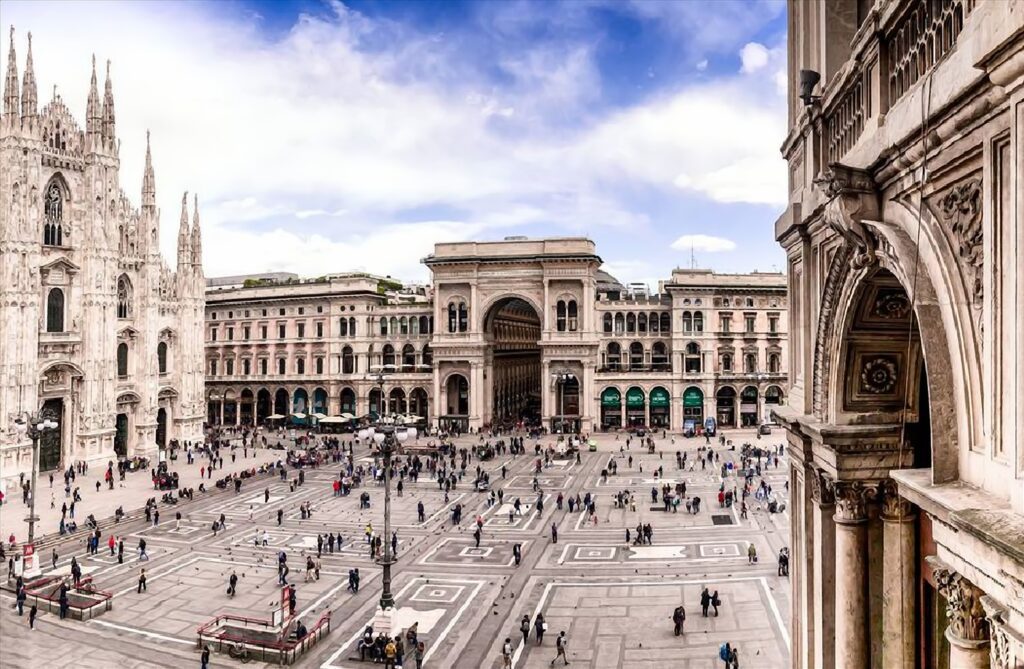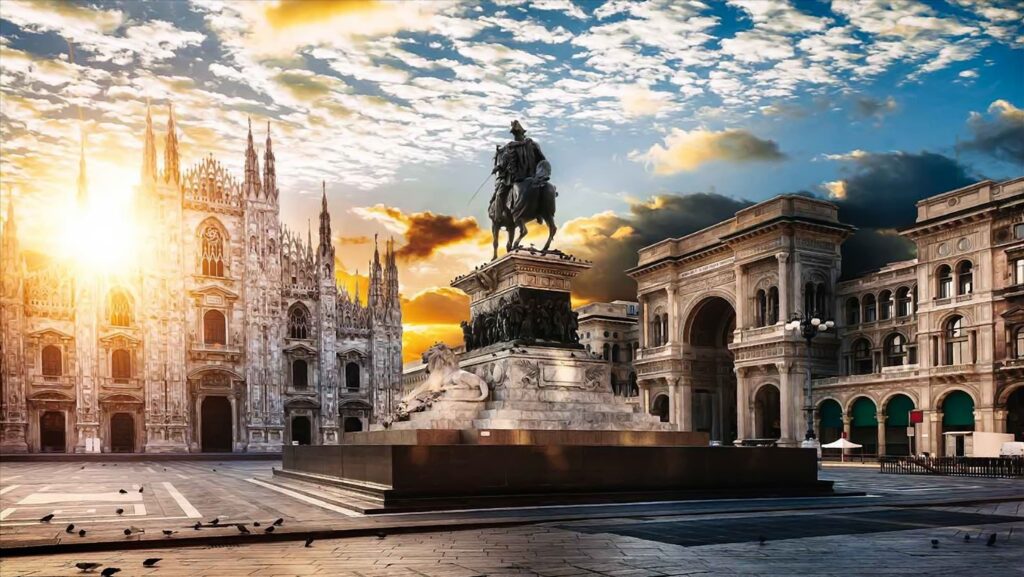

Italy is known for its stunning coastline and beaches, including the Amalfi Coast, the Cinque Terre, and the Aeolian Islands. The country is also famous for its rolling hills, the snow-capped Alps, and the ancient ruins of Rome.
Italy is renowned for its delicious cuisine, which is based on the use of fresh, high-quality ingredients and traditional recipes. Some of the country’s most famous dishes include pizza, pasta, and gelato. Italy is also known for its wine, including Chianti, Prosecco, and Barolo.
Italy is a popular tourist destination, attracting millions of visitors each year with its rich history, art, architecture, and natural beauty. It is home to a few UNESCO World Legacy destinations.
TRAVEL VISA REQUIRMENTS FOR ITALY
The travel visa requirements for Italy vary depending on the nationality of the traveler and the purpose of their trip.
For citizens of the European Union (EU), the European Economic Area (EEA), and Switzerland, no visa is required for stays of up to 90 days within a 180-day period.
For citizens of countries such as the United States, Canada, Australia, and New Zealand, a visa is not required for stays of up to 90 days within a 180-day period for tourism, business, or family visits.
For travelers from countries outside the EU and Schengen Area, a Schengen visa may be required, depending on the purpose of the trip and the length of stay. A Schengen visa allows travelers to visit any of the 26 countries within the Schengen Area for up to 90 days within a 180-day period.
It’s important to check the specific requirements for your country of origin and the purpose of your trip before traveling to Italy. You can find more information on visa requirements and how to apply on the website of the Italian Ministry of Foreign Affairs and International Cooperation.
GEOGRAPHY OF ITALY
Sacred geography refers to the relationship between geography and religious or spiritual beliefs. In Italy, there are many sacred places and pilgrimage sites that are important to the country’s Catholic and Christian traditions.
The Vatican City, located in Rome, is the center of the Roman Catholic Church and one of the most important sacred sites in the world. St. Peter’s Basilica, the Sistine Chapel, and the Vatican Museums are all located within the Vatican City and are revered by Catholics and art lovers alike.
Assisi, a town in focal Italy, is another significant journey site, as it is the origin of St. Francis of Assisi, the benefactor holy person of Italy. The Basilica of St. Francis is one of the most important religious buildings in Italy, and it attracts millions of visitors each year.
Lourdes, a town in the French Pyrenees, is also a significant pilgrimage site for Catholics. Every year, millions of people travel to Lourdes to visit the Grotto of Massabielle, where the Virgin Mary is believed to have appeared to St. Bernadette.
In summary, Italy is home to many important sacred sites and pilgrimage destinations, including the Vatican City, Assisi, and Lourdes, which are significant to the country’s Catholic and Christian traditions. These sacred places are an integral part of Italy’s cultural and spiritual heritage and are revered by people from all over the world.
TRAVEL SAFETY IN ITALY
Italy is generally a safe country for travelers, however, as with any destination, it’s important to take precautions to ensure your safety. Here are some tips for staying safe in Italy:
Keep your valuables safe: Pickpocketing and theft are common in tourist areas, so be mindful of your belongings and keep your valuables safe.
Be aware of your surroundings: Stay alert and aware of your surroundings, especially in busy tourist areas, and avoid walking alone at night.
Be cautious of scams: Be wary of scams, such as people offering to help with directions or sell items, as they may try to steal your money or valuables.
Watch out for pickpockets: Keep an eye on your belongings, especially in crowded areas, such as train stations and markets.
Follow local laws and customs: Follow local laws and customs, especially in regards to sensitive cultural or religious sites.
Take out travel insurance: Consider taking out travel insurance to cover unexpected events, such as medical emergencies, trip cancellations, and theft.
Stay informed about COVID-19: Keep informed about the latest COVID-19 guidelines and restrictions in Italy, as they may change frequently.
By following these tips, you can help ensure a safe and enjoyable trip to Italy.
MONEY AND BANKS IN ITALY
Italy uses the Euro (EUR) as its currency. Here are some tips for using money and banks in Italy:
ATMs: ATMs are widely available in Italy, and using a debit or credit card is a convenient way to access cash. Be sure to check with your bank to ensure your card will work in Italy, and be aware of any international transaction fees.
Currency exchange: Currency exchange offices are available in major cities and tourist areas, but exchange rates may not be as favorable as those offered by banks or ATMs.
Credit cards: Credit cards are widely accepted in Italy, but it’s always a good idea to carry some cash as some smaller establishments, such as local shops and restaurants, may not accept credit cards.
Bank hours: Bank hours in Italy are typically from 8:30 AM to 1:30 PM and from 3:30 PM to 4:30 PM, Monday to Friday. Some banks are closed on weekends.
Tipping: Tipping is common in Italy, and it’s customary to leave a small amount in restaurants, cafes, and bars.
Sales tax: Italy has a value-added tax (VAT) of 22% for most goods and services, which is included in the price of items.
By being mindful of these tips, you can help ensure a smooth and stress-free experience with money and banks in Italy.


FOOD AND DRINKS IN ITALY
Italian cuisine is known for its variety and simplicity, using fresh ingredients and traditional cooking methods. Here are some popular foods and drinks to try in Italy:
Pizza: Pizza originated in Italy and is a staple of the Italian diet. Try different variations, such as Margherita or Prosciutto e Funghi, to taste the authentic Italian pizza.
Pasta: Pasta is another staple of Italian cuisine and is available in a variety of shapes and sauces. Try dishes such as spaghetti carbonara, lasagna, and ravioli.
Risotto: Risotto is a creamy rice dish made with Arborio rice, which is cooked with broth and various ingredients, such as seafood, vegetables, or cheese.
Gelato: Gelato is a traditional Italian ice cream that is creamy and smooth, and is available in a wide range of flavors.
Espresso: Espresso is a strong, black coffee that is a staple of Italian café culture.
Chianti: Chianti is a red wine that is produced in Tuscany and is a popular drink in Italy.
Aperol Spritz: Aperol Spritz is a cocktail made with Aperol, Prosecco, and soda water, and is a popular drink in Italy.
Whether you’re eating at a local trattoria or a gourmet restaurant, Italian cuisine is a highlight of any trip to Italy, and it’s a great way to experience the country’s culture and traditions.
CULTURE OF ITALY
The culture of Italy is characterized by its rich history, art, architecture, music, and cuisine. Italy has a rich cultural heritage that spans thousands of years, and it is the birthplace of the Renaissance. The country is renowned for its contributions to art, literature, and science, and it has produced some of the world’s greatest artists, including Leonardo da Vinci, Michelangelo, and Raphael.
Family is an important aspect of Italian culture, and the country is known for its close-knit communities and warm hospitality. Italians take pride in their traditions and culture, and they are passionate about their food, wine, and fashion.
Italy is also known for its religious heritage, with the Roman Catholic Church playing a central role in the country’s history and culture. Catholicism has a strong influence on Italian art and architecture, and many of the country’s most famous landmarks, such as the Vatican City, St. Peter’s Basilica, and the Sistine Chapel, are religious in nature.
Music is also an important part of Italian culture, and the country has produced many famous composers, such as Giuseppe Verdi and Giacomo Puccini. Italy is also known for its operas, classical music, and traditional folk songs.
In summary, the culture of Italy is diverse and rich, encompassing a wide range of influences and traditions, and it is known for its art, architecture, cuisine, and hospitality. Whether you’re interested in history, culture, food, or music, Italy offers something for everyone.
HOW TO TRAVEL AROUND ITALY
Italy has a well-developed transportation system, making it easy to travel around the country. Here are some ways to get around Italy:
Train: The Italian railway network is extensive and trains are a convenient way to travel between cities and regions. Train travel is fast, comfortable, and cost-effective.
Bus: Buses are a good option for traveling to smaller towns and villages that are not served by trains. Buses are also a budget-friendly alternative to trains.
Flight: Domestic flights are available in Italy and can be a convenient way to travel between cities, especially for long distances.
Car rental: Renting a car is a good option for those who want to explore Italy at their own pace, but be aware that traffic and parking can be challenging in cities like Rome and Florence.
Bicycle: Bicycle rental is a popular way to explore Italy, especially in cities like Florence and Venice, where traffic can be congested.
Taxi: Taxis are available in major cities and tourist destinations, but they can be expensive, especially in peak tourist season. By considering these transportation options, you can choose the best way to travel around Italy, depending on your budget, itinerary, and personal preferences.
HOW TO REACH ITALY
Italy can be reached by various modes of transportation, including:
Flight: The main international airports in Italy are Rome’s Fiumicino Airport, Milan’s Malpensa Airport, and Venice’s Marco Polo Airport. There are also several smaller regional airports that serve domestic and international flights.
Train: Italy is well connected to other European countries by train, and trains are a convenient and popular way to travel between cities.
Bus: Long-distance buses connect many cities in Italy and other countries.
Ferry: Ferries connect Italy with several other countries, including Greece, Slovenia, and Croatia.
Car: Italy can be reached by car via several international roads and highways, including the E45 and E55.
Regardless of how you choose to reach Italy, it’s important to plan your trip in advance and check the latest travel restrictions and guidelines due to COVID-19.
BEST TIME TO VISIT ITALY
The best time to visit Italy depends on your interests and travel style. Coming up next are two or three factors to consider:
Spring (March to May): This is a popular time to visit Italy as temperatures start to warm up, the skies are clear, and the flowers are in bloom. This is also a good time to visit before the crowds of summer.
Summer (June to August): Summer is peak tourist season in Italy, and cities like Rome, Florence, and Venice can be crowded. However, this is a great time to visit if you enjoy outdoor activities and soaking up the sun at the beach.
Fall (September to November): This is a great time to visit Italy, as temperatures start to cool down and crowds start to thin out. The fall is also a good time to visit for food and wine lovers, as this is when the olive harvest and grape harvest take place.
Winter (December to February): Winter can be cold in Italy, but it is also a great time to visit if you’re looking for a more low-key experience. This is also a good time to visit if you’re interested in skiing in the Italian Alps.
Regardless of when you visit, Italy is always full of history, culture, and natural beauty, so you’re sure to have a great time.




